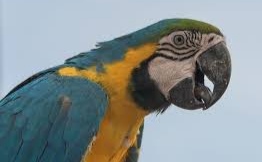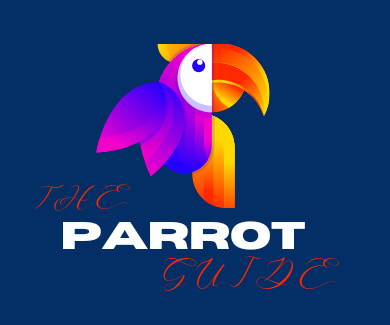Parrots are such birds whose every species is full of surprises. There are many such mysteries in the unique anatomy of their body, among which the parrot’s tongue is a distinct exception.So let’s know about Parrot Tongue Anatomy And Function.
We will describe in detail the anatomy of a parrot’s tongue and how it works in this article. We will also try to find out how the parrot’s tongue helps it to communicate and eat.

What Does A Parrot’s Tongue Look Like?
General Appearance
The parrot’s tongue has the following characteristics:
- Fleshy
- Thick.
- Y-shaped.
- Long enough to extend from the beak.
Some parrot species have different tongues, such as lorikeets. The structure of their tongue is different from that of other parrots, with a brush or hair-like appendage at the tip of their tongue.
Using this they easily collect pollen from flowers, which is a valuable source of nutrition for them in the forest.
Shape
The parrot’s tongue is long, Y-shaped, and ends in an indentation.
The location of the parrot’s tongue helps it to move and use the beak correctly. This bone, called a paraglossal, enables the parrot to grip things firmly and eat easily.
The paraglossal bone is one of 5 different bones of the tongue. When joined together they form the hyoid apparatus..
Its main objective is to:
- Hold it’s tongue.
- Allow the tongue to expand and contract.
Do All Parrots Have Tongues?
All parrots have a tongue; However, parrots use them differently depending on their body size.
Smaller parrots use their tongue to pick up food, while larger parrots use it for many other tasks besides eating.
For example, large parrots such as cockatoos, macaws, and African greys use their tongues to perform various tasks with their beaks, such as picking up and moving objects, and breaking thick or heavy objects.
Whereas, smaller parrots like cockatiels, and budgies do not use their tongues like larger parrots. The main purpose of the tongue is simply to transport food from the mouth to the stomach.
Do All Parrots Have A Bone In Their Tongue?
Parrots have a bone in their tongue that connects to five other bones that support the tongue, known as the hyoid apparatus.
Main functions of the hyoid system
- Provides control.
- Keeps the tongue in place.
- Provides it with mobility.
The 5 bones are called the following:
- Ceratobranchial
- Epibranchial.
- Urohiyaal.
- Basihayal.
- Paraglossal.
Paraglossal which is divided in a Y-shape. This helps parrots understand things with the tip of their tongue.
This hyoid system will adapt to the specific dietary patterns of each parrot.
Therefore, they are structurally similar in all birds but have different characteristics for each species.
The size and shape of each tongue will vary depending on the type of beak.
What Is the Parrot Tongue Made Of?
The human tongue is made up of muscular tissue, on the other hand, the parrot’s tongue is made up of a series of bones called Epibranchial, Ceratobranchial, Urohyal, Basihyal and Paraglossal.
Do Parrots Have Holes in Their Tongues?
Yes, there is a hole at the back of the parrot’s tongue. There will be a hole at the back of the parrot’s beak, at the edge where the base of the tongue begins.
This hole looks like an injury but it is not an injury. This hole is formed by joining together several other bones.
Inside this joint, you can see the glottis. The glottis is a cavity located at the base of the tongue.
It is located just above the larynx and is a part of the respiratory system. (Not to be confused with the syrinx which is the larynx of the parrot).
Parrots do not have an epiglottis like humans do, so their glottis is always open. It resembles a pore, which is always open, even during sleep.
Do Parrots Taste With Their Tongue?
No, parrots cannot taste with their tongue. Although parrots have taste buds and can taste just about anything, their taste buds are located on the back of their tongue, so they will sense taste on the back part of their tongue.
It is important to note that parrots have only 350 taste buds, due to which parrots cannot fully recognise the taste.
Why is the parrot clicking its tongue?
Parrots express themselves and their behavior also depends on how they feel.
When parrots feel happy, satisfied or excited, they often make a clicking sound, which is a distinct and strange sound.
Wild parrots imitate sounds they like. They may listen to the tunes of other parrots or imitate the sounds of flock members..
Parrots learn different words and sounds to entertain themselves and others, often imitating alarm clocks, coughing, and even crying or laughing.
Why Do Some Parrots Have Black Tongues?

Parrot’s tongues can be of different colours, usually it is black, but many parrots’ tongues are pink, or even brown.
It is believed that their tongue colour correlates with their beak colour. The tongue colour of some species is distinctive.
For example, the blue and gold hyacinth has a blue tongue with yellow spots, similarly, the red and black palm cockatoo has a matching red and black tongue.
The colour of a parrot’s tongue never changes, unless it has a health problem.
If the tongue suddenly turns white or yellow, it may be infected, have your bird checked by a veterinarian if this occurs.
Can a parrot get a tongue infection?
Tongues are sensitive so they can get infected. Even a small scratch or injury on the tongue can cause infection.
Many foreign objects cause tongue infections, such as a parrot running its tongue over the bars in a dirty, rusted cage and playing with a broken toy. Infection can also occur through exposure to bacteria and parasites.
The most common infections are:
Poxvirus
Poxvirus badly affects other parts of the body including the tongue.
Their symptoms appear in the form of plaque on the tongue. Companion parrots are unlikely to get poxvirus, but all birds remain at risk.
Poxvirus is insect-borne and its carriers are mosquitoes.
Trichomoniasis
This disease is spread by a parasite called Trichomonas gallinae and this parasite often grows in infected water drinking sources.
This results in severe formation of white plaque (canker) on or around the base of the tongue.
The formation of canker sores can lead to serious respiratory disease.The infection and mortality rates in this disease are high.
Herds infected with canker need to be closely monitored so that they can be treated adequately.
Why Are Parrot’ Tongues Dry?
You may notice that the parrot’s tongue is quite dry, especially near the tip.
This allows parrots to easily catch small objects or pieces of food with their tongue.
Parrots produce limited amounts of saliva, and their salivary glands are located near their throat, so the front of their tongues appears dry.
Parrots swallow food rather than chew it, so they do not need saliva to moisten the inside of the beak.
It is the tongue that pushes food into the oesophagus, where saliva lubricates the food, allowing it to pass through the throat.
What Does the Parrot Tongue Do?
The function of a parrot’s tongue is similar to that of all living creatures, which includes tasting, licking and tasting taste.
Parrots use their tongues to touch, examine, and manipulate objects.
They also use the tongue to eat food and transport it to the throat.
Apart from these general functions, their tongue also helps them imitate words.
Do Parrots Use Their Tongues to Talk?
Parrots do not use their tongues to talk, as they have a larynx called a syrinx.
Both sides of the syrinx can vibrate independently, which helps them make different sounds.
The syrinx is located where the trachea meets the lungs and contains the larynx, just like our larynx.
Parrots use their tongues to adjust sound and the smallest movement of the tongue significantly changes the quality or modulation of the sound they produce.
FAQ
Why Are Parrots’ Tongues Barbed?
Some parrots have barbed tongues that resemble thorns. Such Barbed tongues of parrots help them eat seeds, catch food and communicate.
Are Parrot Tongues Wet?
The parrot’s tongue does not get wet. It is actually dry, especially at the tip, because salivary glands are located at the back of its mouth.
Can a Parrot Injure Its Tongue?
Parrots can injure their tongues even though their beaks protect them from injuries. Most parrot tongue injuries are caused by unexpected events or normal activities
Conclusion
Understanding the anatomy of parrots and what special abilities they have is very important, especially for pet bird lovers.
A pet bird lover needs to know and understand what is the physical structure of parrots and what special abilities they have.
Are you also surprised by the anatomy and function of the parrot’s tongue? Message us in the comment box.
